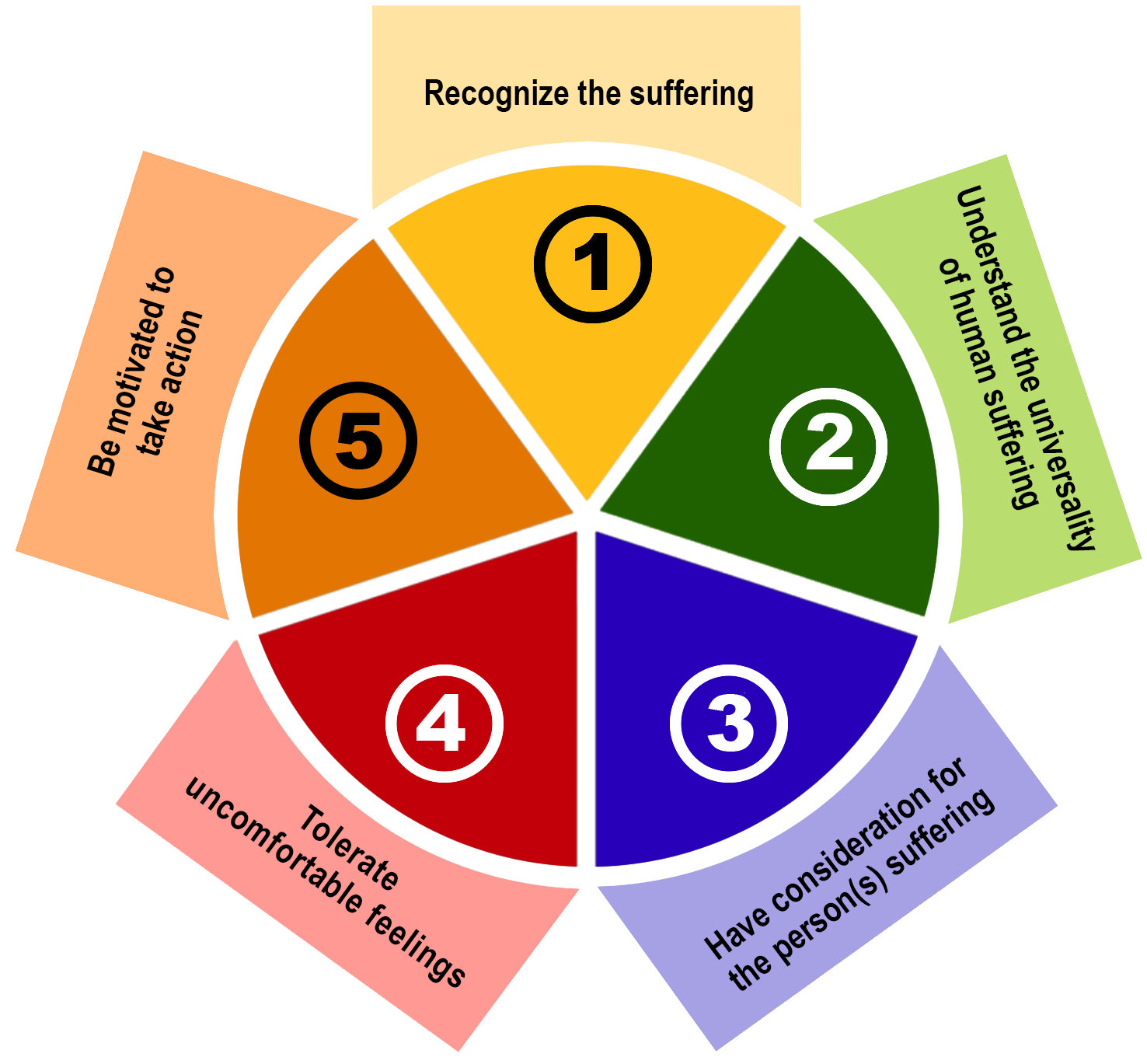|

— Niel Mark Thomas, Unsplash
Human beings often organize themselves into highly refined, complex, and compassionate organizations dedicated to responding to and alleviating pain, suffering, and death.

—
JC Gellidon, Unsplash
There are professional pursuits that are, by their nature, compassionate. Medicine is one of many examples.
Compassion is sometimes confused with empathy, sympathy, pity, and charity. Seeing the definitions may help to clarify the differences.
It's applications
— compassion advocacy, compassion bypass, compassionate action, and applied compassion — can also be confusing.
|
Understanding
the
Meaning of Compassion
Compassion and Associated Terms1
The Five Bodies
In working with compassion and the terms associated with it, we incorporate the "five bodies" concept — a way of punctuating human existence so that we can better understand what it is to be a human being.
The "bodies" are the:
- Physical body — The physical manifestation of a person.
- Emotional body — The feeling nature of a person.
- Mental body — The creative and thinking nature of a person.
- Situational body — The physical, emotional, and mental milieu in which a person exists. This body represents the circumstances in which one finds oneself.
- Transpersonal body — The profound, transcendent knowledge, aspirations and beliefs of a person. Some people incorporate religious or other spiritual practice into the regimen for their transpersonal body (and, thus, is sometimes referred to as the "spiritual" body).
|
|
 |
Each body communicates with and impacts the other bodies.
We often view "suffering" (refer to the discussion below) through the lens of the five bodies (e.g., physical suffering, emotional suffering, etc.).
Compassion
Compassion — because it's a motivation — emanates from the emotional and/or mental bodies. Compassion is sometimes confused with empathy, sympathy, pity, and charity. Its applications — compassion awareness, compassion bypass, compassionate action, and applied compassion— can also be confusing. The definitions below may help to clarify the differences:

Suffering
We categorize suffering in three degrees of severity:
- Necessary Suffering — Painful experiences that are not directly health or life-threating. For example, when a young child learns that they are not allowed to take a toy away from another child, they may experience loss, disappointment, and hurt. This is, indeed, suffering, but it is also part of the child's learning. Such lessons are essential to building depth and resiliency. For adults, first degree suffering can take the form of loss of a loved one, the pains of aging, uncertainty, and other common experiences that come with one's existence. Although necessary, the experience still merits compassion.
- Non-crippling or Non-fatal Suffering — These painful experiences consist of anxiety, stress, despair, illness, injury, or loss that does not cripple or threaten life. Examples are divorce, job loss, temporary sickness, indebtedness, intolerance, shaming, injustice, and exploitation.
- Crippling or Suffering that Risks Death — The most severe form of suffering, this category includes experiences such as crippling injuries or diseases, severe physical and/or emotional trauma, starvation, social group extermination, aggravated assault, murder, fatal exposure to the elements, and fatal diseases and injuries.
The challenge of suffering includes, but is not limited to, endemic rage, racism, corporate exploitation, intimidation, terrorism, hate, intolerance, human trafficking, assaults on women, suicides, torture, political corruption, bigotry, shaming, child abuse, debt slavery, demonizing, rancor, homelessness, bullying, extreme income inequality, manufactured fear, pollution, injustice, and despair.
Organizational
The International Center's focus is on organizations and we look at suffering that directly occurs within those social systems. Among the forms suffering takes are:
| |
- Bullying
- Intimidation
- Discounting
- Humiliation
- Threats
- Miscommunication
- Envy
- Jealousy
- Resentment
- Impatience
- Incivility
|
- Poor communication
- Misunderstanding
- Unfairness
- Favoritism
- Discrimination
- Insufficient pay and benefits
- Domination by managers
- Excessively heavy workloads
|
- Drudgery
- Lack of inclusion
- Disrespect
- Loss of purpose
- Meaninglessness
- Poor working conditions
- Insincerity
- Insufficient mental challenges
|
Individual
Individual, family, racial, and other forms of suffering that impact organizations are also important and is addressed by the International Center. Some statistics indicate the importance of this phenomena:
- In the United States, an estimated 35% of adults are in collection for defaulting on their credit.
- With the economic meltdown in the last decade, 8,8 million people lost their jobs and 1.2 million lost their homes.
- About one in eight American’s were abused as children.
- Research suggests that 350 million people worldwide struggle with depression.
- A report by the London School of Economics and Political Science at King’s College London estimates that depressed employees cost European businesses €96 billion (£77 billion, US $129 billion).
- The World Health Organization (WHO) estimates that more than 700,000 people die from suicide each year.
- WHO also reports that, in the last 45 years, suicide rates have increased by 60% worldwide. Suicide is now among the three leading causes of death among those aged 15-44 (male and female).
- In 2012, there were a total of 2,044,270 reported incidents of crime against women in India.
- African-Americans comprise 13% of the U.S. population and 14% of the monthly drug users, but 37% of the people arrested for drug-related offenses in America.
- In the United States, 1 in 4 women and 1 in 6 men will be sexually assaulted before the age of 18.
- In the United Kingdom, 200,000 Muslims who turn away from their faith are faced with abuse, violence and even murder.
Those in the grips of this suffering lead, work, volunteer for, or otherwise participate in organizations. People struggling with the loss of their job or home, a death in the family, chronic illness, threats from bill collectors, violent crime, discrimination, failure, a devastating childhood and/or experiencing a bleak existence will deal with workplace challenges differently than those who are not plagued by similar torment. Recognizing and and responding to organizational and personal suffering is an important element in moving organizations toward greater ethical, financial, and sustainable success.
Notes
| 1. |
Much of the material for this page is taken from the book (in development), Compassion and the Alchemy of Being, by Ari Cowan. Reproduced with permission. |
| 2. |
Strauss, C., Taylor, B.L., Gu, J., Kuyken, W., Baer, R., Jones, F. & Cavanagh, K., What is Compassion and How Can We Measure it? A Review of Definitions and Measures, Clinical Psychology Review (2016), doi:10.1016/j.cpr.2016.05.004 |
| 3. |
DeSteno, D. (2015). Compassion and altruism: How our minds determine who is worthy of help. Current Opinion in Behavioral Sciences, 3, 80–83. http://dx.doi.org/10.1016/j.cobeha.2015.02.002; Goetz, J. L., Keltner, D., & Simon-Thomas, E. (2010). Compassion: An evolutionary analysis and empirical review. Psychological Bulletin 136, 351–374. http://dx.doi.org/10.1037/a0018807 |
| 4. |
For a further discussion on compassion, see Lim, Daniel & DeSteno, David (2016). Suffering and Compassion: The Links Among Adverse Life Experiences, Empathy, Compassion, and Prosocial Behavior. Emotion, 16, 175-182. http://dx.doi.org/10.1037/emo0000144 |
| 5. |
Condon, P., & Feldman Barrett, L. (2013). Conceptualizing and experiencing
compassion. Emotion, 13, 817–821. http://dx.doi.org/10.1037/a0033747 |
| 6. |
Gilbert, P. (2017). Compassion: Definitions and Controversies. In: P. Gilbert (Ed). Compassion: Concepts, Research and Applications. (p. 3-15). London: Routledge, page 11 |
|





